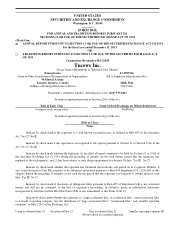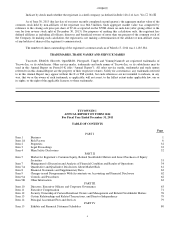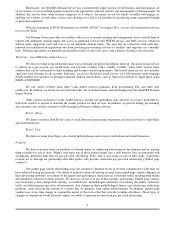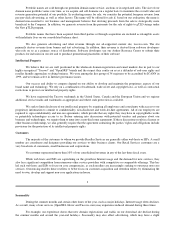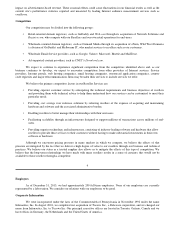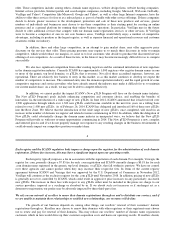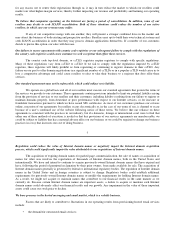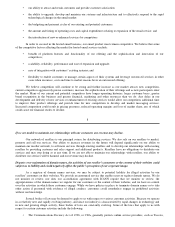Tucows 2013 Annual Report Download - page 9
Download and view the complete annual report
Please find page 9 of the 2013 Tucows annual report below. You can navigate through the pages in the report by either clicking on the pages listed below, or by using the keyword search tool below to find specific information within the annual report.
offer. These competitors include, among others, domain name registrars, website design firms, website hosting companies,
Internet service providers, Internet portals and search engine companies, including Google, Microsoft, Web.com, GoDaddy,
VeriSign and Yahoo!. Competitors like Microsoft, Google and Yahoo!, as well as other large Internet companies, have the
ability to offer these services for free or at a reduced price as part of a bundle with other service offerings. If these companies
decide to devote greater resources to the development, promotion and sale of these new products and services, greater
numbers of individuals and businesses may choose to use these competitors as their starting point for creating an online
presence and as a general platform for running their online business operations. In particular, VeriSign may in the future
decide to offer additional services that compete with our domain name registration services or other services. If VeriSign
were to become a competitor of ours in our core business areas, VeriSign would likely enjoy a number of competitive
advantages, including its position as the largest registry, as well as superior financial and operational resources and customer
awareness within our industry.
In addition, these and other large competitors, in an attempt to gain market share, may offer aggressive price
discounts on the services they offer. These pricing pressures may require us to match these discounts in order to remain
competitive, which would reduce our margins, or cause us to lose customers who decide to purchase the discounted service
offerings of our competitors. As a result of these factors, in the future it may become increasingly difficult for us to compete
successfully
We also face significant competition from other existing registrars and the continued introduction of new registrars
in the domain registration industry. Currently ICANN has approximately 1,000 registrars who register domain names in one
or more of the generic top level domains, or gTLDs, that it oversees. Not all of these accredited registrars, however, are
operational. There are relatively few barriers to entry in this market, so as this market continues to develop we expect the
number of competitors to increase. The continued entry into the domain registration industry and the rapid growth of some
competitive registrars and service providers who have already entered the industry may make it difficult for us to maintain
our current market share. As a result, we may not be able to compete effectively.
In addition, we cannot predict the impact ICANN’s New gTLD Program will have on the domain name industry.
The New gTLD Program's goals include enhancing competition and consumer choice, and enabling the benefits of
innovation via the introduction of a wide range of new gTLDs. In June 2012, ICANN announced that it had received over
1,900 applications through which over 1,300 new gTLDs could become available in the next few years on a rolling basis
related to over 1,400 new gTLDs. As of February 26, 2014 ICANN has delegated and introduced 160 of these new gTLDs
into the Root Zone. We believe that the introduction of the wide range of new gTLDs, once completed, will result in an
increase in the number of domains we register and related revenues commencing in 2014. In addition, while the delegation of
New gTLDs could substantially change the domain name industry in unexpected ways, we believe that the New gTLD
Program will provide us with new revenue opportunities commencing in 2014. The New gTLD Program is a new, complex
and untested process and if we do not properly manage our response to any resulting changes in the business environment, it
could adversely impact our competitive position or market share.
6
Each registry and the ICANN regulatory body impose a charge upon the registrar for the administration of each domain
registration. If these fees increase, this may have a significant impact upon our operating results.
Each registry typically imposes a fee in association with the registration of each domain. For example, Verisign, the
registry for .com, presently charges a $7.85 fee for each .com registration and ICANN currently charges a $0.18 fee for each
.com domain name registered in the generic top level domains, or gTLDs, that fall within its purview. We have no control
over these agencies and cannot predict when they may increase their respective fees. In terms of the current registry
agreement between ICANN and Verisign that was approved by the U.S. Department of Commerce in November 2012,
VeriSign will continue as the exclusive registry for the .com gTLD until November 2018. In addition, pricing of new gTLDs
is generally not set or controlled by ICANN, which could result in aggressive price increases on any particularly successful
new gTLDs. The increase in these fees with respect to any gTLDs either must be included in the prices we charge to our
service providers, imposed as a surcharge or absorbed by us. If we absorb such cost increases or if surcharges act as a
deterrent to registration, our profits may be adversely impacted by these third-party fees.
We rely on our network of resellers to renew their domain registrations through us and to distribute our services, and if
we are unable to maintain these relationships or establish new relationships, our revenues will decline.
The growth of our business depends on, among other things, our resellers’ renewal of their customers’ domain
registrations through us. Resellers may choose to renew their domains with other registrars or their registrants may choose
not to renew and pay for renewal of their domains. This may reduce our resellers’ number of domain name registration
customers which in turn would drive up their customer acquisition costs and harm our operating results. If resellers decide,

